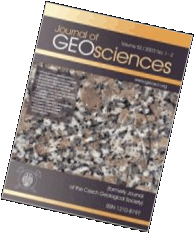 Export to Mendeley
Export to Mendeleycrystal structure
calcurmolite
uranyl-molybdate
modulation
baumoite topology
precession electron diffraction
Original paper
Crystal structure of the uranyl-molybdate mineral calcurmolite Ca[(UO2)3(MoO4)2(OH)4](H2O)˜5.0: insights from a precession electron-diffraction tomography study
Journal of Geosciences, volume 65 (2020), issue 1, 15 - 25
DOI: http://doi.org/10.3190/jgeosci.297
Calcurmolite is a rare supergene U mineral formed during the alteration-hydration weathering of uraninite and hypogene Mo minerals; its structure has remained unsolved owing to a lack of crystal material suitable for conventional structure analysis. Here, single-crystal precession electron-diffraction tomography shows the calcurmolite (Rabejac, France) structure to be modulated; it is triclinic, crystallizing in the super-space group P1(α00)0, with a = 3.938 Å, b = 11.26 Å, c = 14.195 Å, α = 84.4°, β = 112.5°, γ = 133.95° and has a modulation vector q = 0.4 a*. Due to the poor quality of diffraction data, only a kinematical refinement was undertaken, although final results were reasonable: Robs/Rall = 0.3825/0.3834 for 3953/17442 observed/all reflections. The structure of calcurmolite is based upon the infinite uranyl-molybdate sheets with baumoite topology (U : Mo ratio = 1.5) and an interlayer of 6-coordinated Ca2+ cations with interstitial H2O (ligands are apical uranyl O atoms and molecular H2O). Adjacent sheets are linked via Ca-O, as well as H-bonds. The structure formula, based on assumed occupancies in the supercell 5a × b × c, is Ca[(UO2)3(MoO4)2(OH)4](H2O)~5.0 (for Z = 4).
Webdesign inspired by aTeo. Hosted at the server of the Institute of Petrology and Structural Geology, Charles University, Prague.
ISSN: 1803-1943 (online), 1802-6222 (print)
email: jgeosci(at)jgeosci.org


IF (WoS, 2023): 1.1
5 YEAR IF (WoS, 2023): 1.5
Policy: Open Access
ISSN: 1802-6222
E-ISSN: 1803-1943